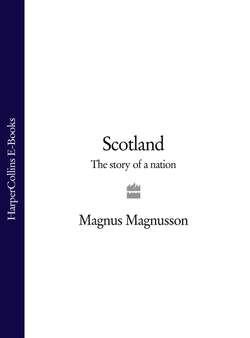Читать книгу Scotland: The Story of a Nation - Magnus Magnusson - Страница 49
The death of Alexander III
ОглавлениеIt is now no less than five hundred and forty-two years since Alexander’s death, yet the people of the country still point out the very spot where it happened, and which is called the King’s Crag.
TALES OF A GRANDFATHER, CHAPTER VI
On 19 March 1286 the king held a session of his council in Edinburgh. It became a convivial affair. The weather grew boisterous as the evening lengthened, but after supper Alexander insisted on setting out to spend the night with his young wife, who was staying in a royal castle at Kinghorn, on the east coast of Fife. It meant crossing the Firth of Forth in the teeth of a northerly gale heavy with snow, and a hazardous journey on horseback through the stormy dark. The boatman at South Queensferry at first refused to sail, but complied after being taunted with cowardice. When they landed at Inverkeithing on the north shore the king was urged to stay there overnight, but he refused and took horse to ride to Kinghorn.
On the seaward side of the busy A921 coastal road between Burntisland and Kinghorn there stands a tall memorial, surmounted by a cross, dedicated to the memory of Alexander III. It was unveiled on 19 July 1886 ‘before a huge concourse of spectators – a red letter day in the history of Kinghorn’, according to the Fifeshire Advertiser of that week. Today few motorists take advantage of the small lay-by next to it to stop to have a look at the memorial and read its inscription:
To the Illustrious
ALEXANDER III,
The Last of Scotland’s Celtic Kings,
Who was Accidentally Killed
Near this Spot
March XIX, MCCLXXXVI
To one side of the road lie the broad sands of Pettycur Bay; on the other stand the shrub-shrouded cliffs along which the king was riding that night. No one knows what happened. The surmise has always been that he became separated from his guides in the darkness, his horse stumbled, and Alexander was thrown and fell to his death at the foot of ‘King’s Crag’, as it was later named, where his body was found next morning. He was buried in the south aisle of Dunfermline Abbey, and all Scotland mourned its king. A scrap of verse, preserved in Andrew of Wyntoun’s Original Chronicle of Scotland (c.1400), records the profound general sense of loss:
Quhen [when] Alexander our kynge was dede,
That Scotlande led in lauche [law] and le [peace],
Away was sons [plenty] of alle [ale] and brede [bread],
Of wyne and wax, of gamyn [sport] and gle [glee],
Our gold was changit into lede [lead].
Crist, borne into virgynyte
Succoure Scotlande, and ramede [remedy],
That stade [placed] is in perplexite.
Alexander’s fatal night-ride is often portrayed as the result of romantic impulse: the ardour of an impetuous lover in the prime of life (he was only forty-four years old) eager to return to the arms of his bride in order to father a son. Be that as it may, his untimely death brought an abrupt end to the mini Golden Age, and plunged Scotland into a fearful constitutional crisis which would lead inexorably to the Wars of Independence with England.
